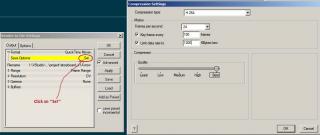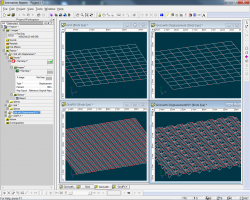-
Posts
4,676 -
Joined
-
Last visited
Content Type
Profiles
Forums
Events
Posts posted by HomeSlice
-
-
The thing that bothers me is, that it's all TWO and SO. It just looks like a preview of the Oz movies. If you can mix in other work, to break up, I think that will help.
Unfortunately all the decent character animation work I've ever done was for TWO and SO. Before TWO, I didn't even know how to animate a character. Since then I've animated on a few other low budget flicks, but the emphasis on those was on *quantity* and *speed*, not something I really want to show on a demo reel. I've done other types of animation over the years, but this is a character animation reel. So I'm afraid TWO and SO is all I have to draw from...
-
Unless you really need to render huge Quicktime movies with alpha channels, I would suggest rendering to h264 codec and playing with the bitrate until you find a good compromise between file size and quality.
HomeSlice,
How do I set up Quicktime to render in the h264 codec. Nothing I can find in the render dialog box would allow me to do so.
I don't know how it looks on a Mac, but here is a screenshot from WinXP.
After you render the movie in AM, open it in Quicktime Pro and export it with the same settings (from Quicktime Pro), except for audio choose AAC for the codec. This will make the file size even smaller with only a marginal loss in quality.
This will be good for quick test renders and for short renders you want to share on the internet.
For your final rendered piece, follow Fuchur's advise.
-
Like Robcat says, ultimate control comes with manually animating things. Anything that can possibly be manually animated, even if it is a lot of work, do it manually. It will actually same you some time and frustration.
If you really need a simulation,
Newton will handle most hard and soft body dynamics. Unfortunately, I do not know of a comprehensive Newton tutorial.
Here are some helpful links:
http://www.hash.com/NewtonPhysics/
http://www.hash.com/NewtonPhysics/samples.html
http://www.hash.com/forums/index.php?showt...0&hl=newton
http://www.hash.com/forums/index.php?act=A...st&id=19636 ( PDF File)
SimCloth handles cloth. Here is a simCloth tut in pdf format (with a sample project file) http://www.hash.com/forums/index.php?showtopic=29731
Hair can be useful in a wide variety of situations, from actual hair, to feathers, to foliage on plants. Here is a tutorial on hair.
-
Awesome tips. Thanks guys!
Jimd, you are not offending anyone, at least not me. The people I send this to will probably be much more critical, so I need "real" evaluations.
Thanks largento. I had not even considered most of those points.
Thanks Robcat for taking the time to look at it on a more granular level.
-
Happy b'day doood.
-
Your improvement is profound between TWO and SO.
Thank you Myron. After all the hours I've put in, I sure hope I've improved at least a little bit.
And THANK YOU for your music in SO!!
looks great!!!!!!!!!!!!!thank you Spleen. But I'm trying to shorten it down to 2-3 minutes, so I need to cut out some clips. But I'm just not sure which ones to cut...
-
I just clicked on the link and it started downloading. Maybe try it again?
-
Maybe those wooden beams could be more rumpled to go with the windows?
Oh yes, make the beams match the style of the windows. That would look better.
That looks like a tavern fit for Flemm!
-
I'm working on an animation demo reel. It was all animated in A:M, so I thought the WIP forum would be appropriate.
What I have now is about 5 min in length. I've heard that 2-3 minutes is optimal for a demo reel, so I would like to trim it down to that. I would be grateful if you will look at what I have and tell me what clips you like and what clips ... not so much.
Here is the link to a low resolution version with frame numbers:
http://www.holmesbryant.com/files/video/Ho...Demo_draft1.mov (27MB)
Thanks
-
Unless you really need to render huge Quicktime movies with alpha channels, I would suggest rendering to h264 codec and playing with the bitrate until you find a good compromise between file size and quality.
For your test renders, limit the data rate to 1200 KB/sec or less.
For your final render, render out to individual tga or png frames for best quality and to prevent you from having to rerender that entire sequence if something happens (power outage, crash, whatever).
Animation Master can import the image sequence you rendered, add your audio to it and render a quicktime movie with the audio.
Make a new Project.
Import your image sequence.
Import your audio.
Make a new choreography.
Drag your image sequence onto the camera in the choreography (as a camera rotoscope).
Add your audio to the choreography.
Render movie.
It will render much faster than the original 3D scene because A:M is just processing the 2D images and audio.
-
If you can point him to some documentation about what a proper PLY header is that might expedite it.
Just did it.
-
-
When you order the CD (or the subscription), it will likely come with some flavor of version 15. That is the latest official release. You will want to update that to v15J. Version 16 is still in beta. Many people are already using it, but it is still being tweaked.
If you are doing something with deadlines, something you may want to try is installing both v15J and v16 (v16 installs into a different directory, so you can have both installed). V16 comes in 32bit and 64bit flavors, so install the 64bit version if you have a 64bit OS. Then create your assets and animation in v15J. Then copy those files to a new (v16 projects) directory and render them with v16.
The reason is that v16 renders much faster. On a PC it is substantial, but on the Mac it is an order of magnitude faster. Plus, a limited version of Netrender is available in the beta that allows you to render animations on two cores of your cpu (or two single core computers) at the same time. Netrender is also handy for setting up a large batch of choreographies to render unattended. Netrender won't speed up the rendering of a single image, however. A single frame will only render on a single core.
-
Unfortunately, the PLY plugin exports a binary file, although technically the ply format ca be either binary or ascii.
-
Oh boy, you have your work cut out for you!
-
I've tested further and found that something about displacement creation is making the bumps. An object without a displacement map doesn't get the bumps.
Here's a test of exporting two grids, the one on the right has a flat gray displacement map on it. Teh bottom two windows are the PLY result imported back in.
I've put that in as a "minor" priority AMReport.
Do you know what the issue ID is? Since you already created a ticket, I would like to add a note to say that AM's ply files are also missing the proper headers.
-
Nice work but it looks like she already had the guns!
Yep, those "44s" are pretty impressive!
-
It looks like Apple has decided to boycot USB 3.0 just like they did with blu-ray. They excluded Blu-ray burners from their computers because Blu-ray competes with Itunes movie rentals that are also in HD.
Apple is copying the tactics of their arch-nemesis Microsoft. It is getting them big profits today, but in time they will encounter the same backlash as MS. Then people will be calling them $pple
 I get my 1.2 Mbps here in Dallas for $25 per month.I pay $40 per month after taxes and get 6Mbs download and 1Mbs upload.
I get my 1.2 Mbps here in Dallas for $25 per month.I pay $40 per month after taxes and get 6Mbs download and 1Mbs upload.I'm jealous. Qwest charges me $45/mo for 1.5 Mb/s
From what i can tell the fastest broadband available in the home is 160 Megabits per second, in Japan, at a cost of ~$60 per month.Chattanooga TN offers Gigabit internet speeds (1000 Mb/s) at a cool $350/mo.
http://www.engadget.com/2010/09/13/chattan...ce-just-350-pe/
If 14 people in Chattanooga form a cooperative, they can each get 71Mb/s for $25/mo

-
Shouldn't he have a heart shaped bed with red satin sheets?
-
Is there a reason to use PLY instead of OBJ?
From what I understand, PLY was inspired by the obj format, but ply was developed to handle extremely high density meshes, such as those created from high resolution 3D scanners and such. For our purposes though, I imagine OBJ is just fine.
I was just wondering if it was still possible to export an A:M model with a displacement map into PLY and get the displacement baked into the model as actual geometry.
-
Here is a bunny model in ply format (I think)
ftp://graphics.stanford.edu/pub/3Dscanrep/bunny.tar.gz
from the Stanford 3D scanning repository
http://graphics.stanford.edu/data/3Dscanrep/
Those guys should have bona fide guaranteed ply files.
Try to open it in UUnwrap. If it still gives you problems, then it is definitely a problem with the plugin in UUnwrap.
-
Blender can import ply files, I do have the newest stable version installed if you want me to test anything.
Sure!
Create a simple model in A:M - like a 32patch sphere or something.
Export it as PLY.
Try to open it in Blender.
Did it work?
-
SWEET Powersled! Where can I buy one?

-
.... (Then I exported model with UV maps from A:M to Zbrush and convert bump maps to actual geometry):
You used to be able to convert displacement maps to geometry in A:M. Export to AV2 or PLY. But I haven't tried it in many years, so it may not be possible anymore.
Unfortunately, I haven't found a program that can open PLY files exported from A:M. I think they complained that A:M's ply files did not have the proper headers. The workaround is to open the ply/AV2 model in AM and export to obj.












Cupids Bedroom
in Design Dynamics presents
Posted
That looks like a bed fit for a cupid